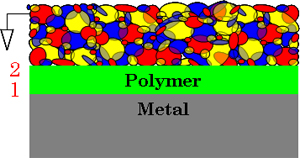One of the challenges in developing robust multilayers is the need to predict the interfacial strength between hard and soft materials. For example, in the case of drug eluting stents that are being used increasingly to treat arteriosclerosis, there are concerns that the drug-eluting layer may detach from the polymeric layers that are used to attach the soft drug eluting layers to the hard metallic stent substrate. To address these issues, a collaboration between PCCM researchers and scientists at nearby Johnson & Johnson has developed new ways of linking molecular measurements of adhesion (atomic force microscopy measurements of adhesive interactions between bi-material pairs) to macroscale surface measurements of adhesion (from interfacial fracture mechanics). A combination of adhesion theories and crack-tip shielding concepts were used to predict the macroscale interfacial fracture toughness of interfaces between soft and hard materials. This provides the basis for the fast screening and design of interfaces that are relevant to both drug eluting stents and flexible electronic structures. 
Top:Â’ Schematic of layers in drug eluting stent, Bottom: Plots of measured and predicted energy release rates obtained for different mode mixities.